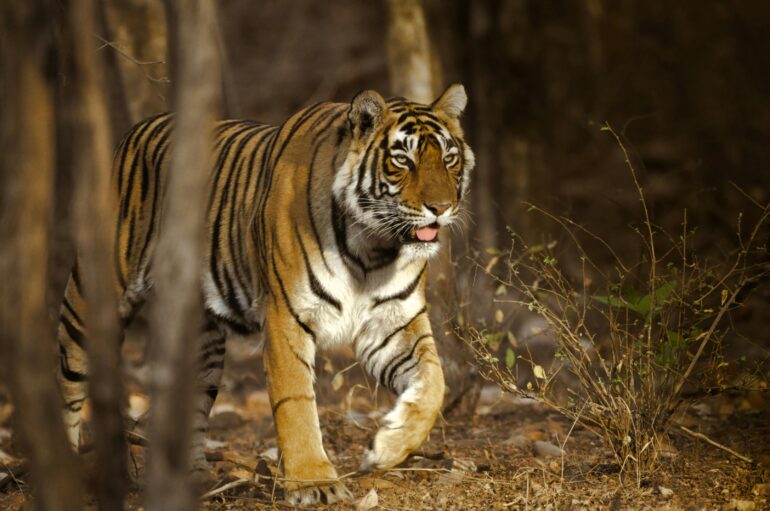Rajasthan, the largest state of India geographically, is one destination that is on the bucket list of all travellers across the country and even the globe. The state and its several cities are known for the myriad cultural and heritage specialities like forts, palaces, havelis, dances, and music. The Thar Desert, of course, has a charm of its own, attracting tourists especially in the winters. But what if somebody told you that Rajasthan is not just “the desert state” and there’s much more touristy-ness in its natural ecosystems? Pleasantly surprising, right? Read on to find out how the state can offer nature lovers the time of their lives.
Into the Wild: The state’s many wildlife safaris
Here’s a beWILDering fact: there are more than 25 national parks and sanctuaries in Rajasthan. The Ranthambore National Park is situated in the Sawai Madhopur district and has a vast expanse of about 392 sq km. The Park is known for the majestic Bengal Tiger that one can see during the jungle safaris. Keoladeo Ghana National Park (Bharatpur district), Sariska Wildlife Sanctuary (Alwar district), Jamwa Ramgarh Wildlife Sanctuary (Jaipur district) and Kumbhalgarh Wildlife Sanctuary (Udaipur, Rajsamand, and Pali districts) are also frequented by wildlife enthusiasts and regular tourists alike. But there are many lesser-known but exciting sites too. The Desert National Park, located in Barmer and Jaisalmer districts, is among the country’s largest parks, spanning across more than 3000 sq km. One can head here to understand how ecosystems function in extremely challenging environments, or if lucky, can also spot the Great Indian Bustard, the State Bird of Rajasthan and among the most critically endangered birds of India. Other sites include Bassi (Chittorgarh district), Sita Mata (Chittorgarh and Pratapgarh districts) and Jawahar Sagar (Kota district), among others.
Down South: Unimagined natural hotspots
Though Rajasthan ranks among the lowest states in the country as far as forest cover and productivity is concerned, thanks to arid climatic conditions, Southern Rajasthan (including districts like Pratapgarh, Banswara, Udaipur, Chittorgarh and Dungarpur) is an exception. More than a fifth of the total geographical area under Pratapgarh and Udaipur districts is under forest cover, as per ISFR 2021 (report of the Forest Survey of India). The region lies at the confluence of the Aravalis, Vindhyas and Malwa and is thus a hotspot for flora and fauna. The forests are mostly teak and bamboo mixed; the region forms the northwesternmost limit of Teak Zone in India; and there are biotic elements from the rich ecologies of the Deccan and Western Ghats. Overall, the landscape is picturesque; with perennial rivers, streams, gorges and dense woodlands, the region is serene, especially right after monsoon. One can visit these districts and head out for treks and walks. The Sita Mata Wildlife Sanctuary, which is about 25 km from the Pratapgarh town, has the largest biota of Rajasthan. The rest houses operating in the area also organise eco-treks for the benefit of travellers.
Islands and Rivieras
Yet another fascinating fact about Rajasthan is that there are riverine islands here. Yes, you read that right! If you’re not living under a rock, you might know that Udaipur, the City of Lakes, has serene lakeside properties to cater to lthe uxury demands of guests. But if offbeat is on your mind, there are many other options for riverside and lakeside tourism as well. Head over to Rajsamand, which is close to Udaipur, to witness the world’s second-largest manmade lake which goes by the same name as the city. The lake was constructed in the 17th century and is the catchment area for three rivers. If camping is what excites you, picture camping on pristine and isolated islands and then arrive at Banswara to accomplish the same. The district situated on the banks of Mahi River, is popularly known as the Land of a Hundred Islands. While some islands are only accessible through ferries or boats, some like Chachakota, can be reached by road. The Chambal River which flows through the east and south-east of Rajasthan, makes beautiful gorges across districts like Kota and Bundi. Four main dams on the perennial river are worth visiting on their own too. If you’re planning to take a road trip across Rajasthan, do it along the banks of these rivers, right after the rains. The lush greenery on mid-height hills, waterfalls every now and then, and slightly rough but adventurous terrains is the perfect off-roading getaway.
Though these and other off-beat sites in Rajasthan aren’t as developed for tourists as of now, this also means that arrivals at these places are few and those visiting can continue to enjoy the pristineness and peace, away from the other popular locations that are crowded around the year.


